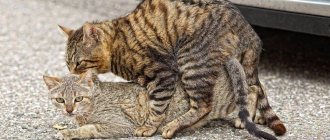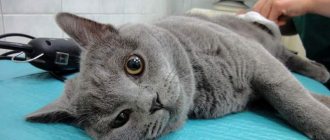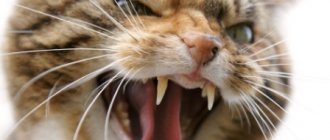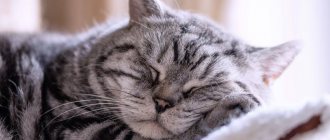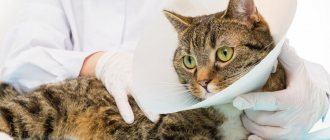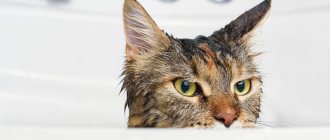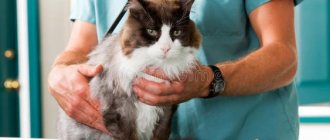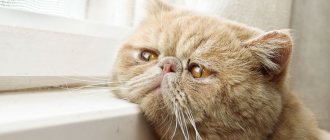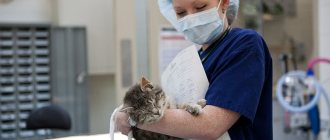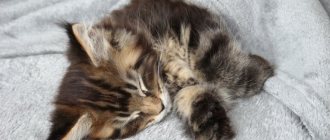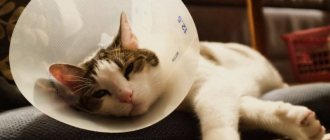Many owners who decide to castrate their pet are often tormented by doubts for a long time. The fact is that over the entire period of its use, a lot of rumors and outright misconceptions have arisen around the sterilization procedure, which does not add confidence to breeders who fear for the health of their pets. Thus, it is believed that a cat’s behavior can change dramatically after castration. Some cat lovers even believe that the cat will immediately lie down on the sofa and quickly begin to get fat... But is this really so? Let's find out!
What to expect in the first hours after castration?
In general, nothing significant, especially in cases where castration was carried out under general anesthesia. The fact is that your pet will sleep for at least three to four hours after the operation. Making loud noise and, especially, trying to wake him up at this time is not the best idea. Moreover, it is recommended to place the animal in a separate darkened room so that the process of recovery from anesthesia is more gentle and natural.
Evidence of a cat’s normal condition is:
- Calm and measured breathing. By the time awakening begins, it becomes more superficial and frequent.
- Normal body temperature. The animal should be neither too cold nor too hot.
- Visible mucous membranes should have a normal pinkish tint.
As a rule, by the time the veterinarian allows you to take the cat home, the animal begins to recover from the effects of general anesthesia, and therefore basic reflexes should appear. In particular, when the cat's skin is pinched or tingled, twitching and muscle contractions should be noted.
By the time the animal begins to wake up, the intensity of the reflexes will increase.
In cases where the pet does not respond to anything after about five hours after the operation, its breathing gradually slows down, and the mucous membranes turn pale, it is necessary to urgently call a veterinary specialist.
Influence on urination in the wrong place
Dogs and cats may urinate or defecate in unwanted areas of your home to cover territorial claims, relieve anxiety, and advertise reproductive status. This may continue long after the initial cause has passed.
Because this behavior is controlled in part by hormonal status, male or female pets may begin to defecate inappropriately even after spaying. Sterilizing an animal that begins to urinate in the wrong place reduces the odor of the urine and eliminates the contribution of hormonal factors. If underlying emotional or physical factors are not controlled and environmental reminders are removed, unwanted behaviors may persist after spaying or neutering.
How high is the likelihood of complications?
It is believed that surgical infertility is a “frivolous” operation. But only those who have no idea about surgery in general think this way. Any surgical intervention that requires local or general anesthesia always carries potential risks, including the possibility of death. Fortunately, this is extremely rare, but sometimes complications do occur. Therefore, you should carefully monitor your operated pet in order to notice signs of something wrong in time.
These are the symptoms that should promptly call a veterinarian:
- The cat's breathing is bothering you. It may slow down too much, become hoarse, choppy, etc. All these signs indicate some kind of problem with the cardiovascular system and/or lungs.
- The pet's visible mucous membranes have turned blue or very pale. This also directly indicates problems with the blood supply to organs and may be evidence of aggravated pathologies of the cardiovascular system.
- The animal wheezes, twitches unnaturally, and vomits.
- Call a veterinarian immediately if you notice that your cat's operated scrotum is bleeding heavily. This may well indicate damage to some large blood vessels (for example, in the penis of a cat), or poor tightening of the ligature. In all these cases, the animal may well die from blood loss in just a few hours.
How does a cat behave when it wakes up?
Most likely, you shouldn’t expect absolutely adequate behavior from a barely awakened pet. Of course, he is unlikely to walk around the apartment trying to catch non-existent butterflies (and this doesn’t happen to people), but there will be certain oddities.
Based on this, veterinarians give a number of tips to owners of operated animals:
- There is no need to place your pet on sofas, ottomans, beds and any other places where he could fall. Remember that after anesthesia, your cat, usually so graceful and dexterous, may remain for some time in a state of “vegetable”, with little idea of where he is and what he is doing. The problem is that an animal with poor motor coordination (and due to general anesthesia it always is) can fall and be seriously injured, even if the height of the fall is measured in a few centimeters.
- Don't expect your cat to immediately remember where his litter box is. A disoriented animal simply will not reach it, creating a puddle somewhere along its route. So place the litter box within the cat's line of sight and reach.
- The same applies to a bowl of clean drinking water. There is no need to place it half a kilometer away from your barely awakened pet on the first day after sterilization. It is unlikely that he will be able to walk a long distance without falling or, again, making a puddle under himself.
During the first hours, your pet will need special care. He needs to be constantly watched. Remember that in some cases, again, you need to call a veterinarian immediately. So, if a cat decided to go to the toilet “in a big way”, but it didn’t turn out very well (the back of the body is stained with feces), then the dirt should be immediately removed and the doctor should be called immediately.
The problem is that the area of the operated scrotum is likely to be contaminated with pathogenic and conditionally pathogenic microflora. Most likely, you will have to prescribe the cat a course of antibiotic therapy. Otherwise, there is a high probability of sepsis and subsequent death of the animal.
Will my pet become obese after surgery?
Many owners are wary of castration for another reason. They agree that cats, as a rule, easily tolerate this operation, but they are afraid that after it the pet may become very fat. Note that Scottish Fold cats are especially susceptible to this scourge, but it’s not that bad.
Research from the Cornwall and Sydney Veterinary Institutes has revealed that neutered animals require (on average) approximately 25% less energy and nutrients when compared to the needs of non-neutered animals.
The reason is simple - castrates have a slower metabolic rate (that is, metabolism). If they are fed in the same way as before the operation, the animals' bodies will automatically store excess nutrients in the form of subcutaneous fat.
In cases where owners follow the veterinarian’s recommendations and reduce the calorie content of their pet’s diet, nothing like this happens. In addition, it is strongly recommended not to feed sterilized animals with fish, as this increases the risk of urolithiasis.
Does the surgical area hurt due to castration?
In most cases, no noticeable pain reaction develops, but it may be indicated by a change in the cat's behavior. Most veterinarians believe that an animal over four years of age should be given sedatives for the first two days after surgery to relieve discomfort in the groin area. Most likely, the post-operative wound is very painful if you observe the following signs:
- The cat snarls and hisses every time you try to probe the area of the post-operative wound. Do not be offended by your pet: he is in a lot of pain, and therefore restless behavior and aggression are his only way to show how severe the pain is.
- The pet completely refuses even the most delicious food.
- The cat half sits and half lies on its stomach, its limbs are tightly tucked together, the animal looks intently at one point and reacts with obvious reluctance to any external stimuli. This behavior indicates very severe pain that requires immediate relief.
The role of painkillers
The role of pain medications is much more important than is commonly thought. Thus, they not only improve the quality of life of the operated animal in the first hours and days immediately after castration, but also help improve appetite (if the cat is not in pain, he will eat much more willingly). Consequently, sedatives help normalize metabolism faster, and this is extremely important.
In addition, severe pain impairs the normal functioning of the endocrine glands, kidneys, lungs, heart, liver and other internal organs. Again, painkillers help prevent this. Finally, these medications normalize the cat’s behavior: if the animal does not experience pain, it will be much more adequate.
Cats (precisely cats) have one physiological feature. When the pain is severe, they often develop a powerful spasm of the urethral canal, as a result of which the pet is physically unable to pass “little by little . In this case, the cat becomes nervous, irritable, can spin in one place for a long time, and constantly pushes. Despite all the efforts made, the animal manages to squeeze out only a couple of drops of urine. As a rule, 1/6 of a No-Shpa tablet helps, but you should only give it yourself as a last resort. If possible, call a veterinarian: one injection of antispasmodics can completely solve the problem.
A reduced frequency of urination in the first days after castration is completely normal.
As a rule, the animal eats little and does not drink too much during this time. In addition, the body compensates for fluid loss, and therefore less urine is produced. It is much worse when a cat constantly and profusely pees due to castration. Polyuria in this case may be a sign of kidney damage due to incorrectly selected agents for local or general anesthesia.
If you notice that your pet is constantly using the litter box, but is acting normally (i.e., he is not showing signs of pain characteristic of urethral spasm), be sure to tell your veterinarian.
There is no need to try to alleviate your pet’s condition using the arsenal of your home first aid kit. It is unlikely that you will be able to relieve the pain, but you will certainly be able to cause serious damage to the cat’s health (or even kill him).
The fact is that painkillers are developed based on the characteristics of the biochemistry of a particular type. And it just so happened that the bodies of cats and humans are different in many ways. In particular, paracetamol, which is one of the most common painkillers in medicine (and fairly safe for humans), can easily kill your cat. Or cause severe pathologies of the hematopoietic system, which is no better than a quick death. So don’t take risks, and a cat’s strange behavior is always a “good” reason to call a veterinary specialist.
Appetite and food preferences
If the operation was performed efficiently, the cat’s condition should stabilize during the first two days after the procedure, and then the pet’s behavior will almost return to normal. In particular, your pet will probably want to eat. Thirst should appear within the first hours after recovery from anesthesia. If your cat does not eat well or does not eat at all for three days, you should immediately seek help from a veterinarian.
Many experienced cat lovers know that castrates need less nutrients, and therefore immediately adjust the animal’s diet towards reducing its nutritional value.
Yes, castrated cats really shouldn’t be overfed to avoid obesity, but only during the first two weeks will your pet’s body recover from the consequences of the operation. Additional nutrients will not harm him at this time. In addition, tasty food will make the cat calmer and minimize the effects of stress.
It is also known that the hormonal changes that occur in the body of castrates in some cats lead (at first) to a noticeable decrease in body weight. The conclusion is simple - the cat will be calmer, and his body will recover much faster if his diet does not change in any way in the first month from the moment of castration. You can even make it a little more nutritious, but you'll need to check with your veterinarian first. You need to radically change your diet gradually, during the first month after surgery.
We can draw some conclusions. So, a cat that has undergone castration may be somewhat out of it at first. There is nothing strange or frightening about this: this is how the effects of anesthesia manifest themselves. In particular, at first the cat may be twitchy, and the coordination of its movements seems unnatural. Your cat may pee under itself without reaching the litter box; this may be a consequence of the operation.
Finally, you shouldn’t expect your cat to immediately pounce on the food and start playing casually - his body needs some time to fully recover. In addition, overeating and physical activity during such a period are generally contraindicated.
Wound care
During the recovery period, the owner should inspect the stitches 1-2 times a day and ensure that there is no bleeding. To speed up the healing of the wound, it is lubricated with hydrogen peroxide, brilliant green or Levomekol ointment. If the cat shows increased attention to the wound and constantly licks it, a special collar should be put on the animal. It will protect the seam from coming apart under the influence of your pet’s rough tongue.
To avoid wound infection, after each visit to the toilet, the tray should be thoroughly washed and treated with an antiseptic. Antibiotics can also be used to prevent infections, but be sure to consult a veterinarian before use.
